Experimental Analysis of Calculation of Fuel Consumption Rate by On-Road Mileage in a 2.0 L Gasoline-Fueled Passenger Vehicle
Abstract
:1. Introduction
- Many external factors, such as driving conditions, accumulated mileage, traffic conditions, temperature, weather conditions, etc., affect fuel economy. Also, rapid acceleration/braking, high-speed driving, excessive use of air conditioners, unnecessary loading of cargo, excessive use of electrical equipment, and four-wheel drive, all contribute to fuel efficiency.
- Maintenance status of the vehicle, fuel quality, and condition of the car also affect driving conditions.
2. Experiment Description
2.1. Vehicle Specification and Test Description
2.2. Three Regulatory Driving Cycles
2.3. 4-Equations for Calculation of the Unadjusted and Adjusted Fuel Consumption
3. Results and Discussion
3.1. Comparision between Fuel Consumption Resullts Obtained From A, B, C and D Equations
3.2. Comparison between CO2 Emissions in FTP75, HWFET, and US06 Drive Cycles According to 0, 6500, 15,000 and 30,000 km Mileage
3.3. Detailed Analysis of the US06 Cycle
3.4. Estimation of Fuel Efficiency within 100,000 km Mileage Based on These Test Results
4. Conclusions
- (1)
- There is some difference in fuel consumption for city and highway modes between values calculated from Equation A considering only one driving environment, FTP-75 mode, and results in Equation C and D that help to derive fuel economy when considering various driving environments, including fuel consumption measured in several cycles that were established by the EPA. Conversely, it appears that the Equation B adjusted fuel consumption developed from the EPA cannot consider various driving environments that affect fuel economy.
- (2)
- When the amount of CO2 exhaust gas was measured according to mileage of the vehicle in three drive cycles used in this study, it increased in the entire cycles as the engine ages after 6500 km of cumulative mileage of the vehicle. In particular, the greatest growth rate of CO2 emissions was revealed in the US06 cycles, among those cycles with the aging of the engine. In contrast, the remaining two cycles revealed an increase rate of CO2 emission less than the US06 cycle after 6500 km, and a similar amount of CO2 exhaust gas was emitted between 15,000 km and 30,000 km.
- (3)
- Factors affecting CO2 and CO exhaust gas as the vehicle’s cumulative mileage increases are analyzed in the US06 driving cycles, which include urban and highway modes. In the region wherein low load is applied on the engine, CO2 and CO are discharged, irrespective of aging of the engine. In the region, wherein middle load is taken on the engine, fuel consumption is worse with the aging engine, depending on the engine’s temperature. In addition, it can be observed that when the vehicle accelerates while moving, it is more easily faced with the atmosphere that complete combustion is difficult to achieve in comparison with when the engine in a stationary state is applied on the load. Finally, in the regions wherein high load is applied on the engine, unlike for the middle load case, CO2 emissions increase as the engine ages, regardless of the temperature at which the engine is operated.
- (4)
- How much fuel economy of the test vehicle would deteriorate in the city and highway modes of the US06 driving cycle within the 100,000 km cumulative mileage of the vehicle was predicted. Even though the fuel consumption value calculated by the empirical formula cannot be completely relied on, it may help to identify the tendency of fuel economy value. The fuel consumption values that were obtained from the empirical formula are well consistent with the above results.
Author Contributions
Funding
Conflicts of Interest
References
- Kim, J.W.; Park, J.M.; Kim, T.K.; Lee, J.W. Verification and Development of Simulation Model for Fuel Consumption Calculation between ICEV and PHEV. J. ILASS-Korea 2017, 22, 47–54. [Google Scholar]
- Korea Petroleum Quality & Distribution Authority. US EPA-Cycle, MPG Fuel Economy Trends and Fuel Cost Calculation Method; Research Institute of Petroleum Technology: Chungcheongbuk-do, Korea, 2010. [Google Scholar]
- Environmental Protection Agency. Fuel Economy Labeling of Motor Vehicles: Revisions to Improve Calculation of Fuel Economy Estimates; Final Rule 40 CFR Parts 86 and 600; Environmental Protection Agency: Washington, DC, USA, 2006.
- Lee, M.H.; Lim, J.H.; Kim, S.W.; Kim, J.H.; Kim, K.H.; Jung, C.S. A study on the developments of vehicle fuel economy and CO2 emission correction formula according to the new test method; KSAE 12-B0100. In Proceedings of the KSAE Fall Conference, Seoul, Korea, 21 November 2012. [Google Scholar]
- Lim, J.H.; Kim, S.W.; Lee, M.H.; Kim, K.H. Study on new type vehicle fuel economy correction formula review according to the applicable. J. Energy Eng. 2016, 25, 198–206. [Google Scholar] [CrossRef] [Green Version]
- Environmental Protection Agency. Fuel Economy Labeling of Motor Vehicles: Revisions to Improve Calculation of Fuel Economy Estimates; EPA420-D-06-002; Draft Technical Support Document; Environmental Protection Agency: Washington, DC, USA, 2006.
- Lee, D.W.; Jeremy, J.; Jinpeng, L.; Kristen., N.; Josias, Z. Comparisons between Vehicular Emission from Real-World In-Use Testing and EPA Moves Estimation; Texas Transportation Institute: College Station, TX, USA, 2012. [Google Scholar]
- Delogu, M.; Del Pero, F.; Pierini, M. Lightweight Design Solutions in the Automotive Field: Environmental Modelling Based on Fuel Reduction Value Applied to Diesel Turbocharged Vehicles. Sustainability 2016, 8, 1167. [Google Scholar] [CrossRef]
- Koot, M.W.T.; Kessels, J.T.B.A.; de Jager, A.G. Fuel reduction of parallel hybrid electric vehicles. In Proceedings of the 2005 IEEE Vehicle Power and Propulsion Conference, Chicago, IL, USA, 7–9 September 2005. [Google Scholar]
- Zhang, S.; Wu, Y.; Liu, H.; Huang, R.; Un, P.; Zhou, Yu.; Fu, L.; Hao, J. Real-world fuel consumption and CO2 (carbon dioxide) emissions by driving conditions for light-duty passenger vehicles in China. Energy 2014, 69, 247–257. [Google Scholar] [CrossRef]
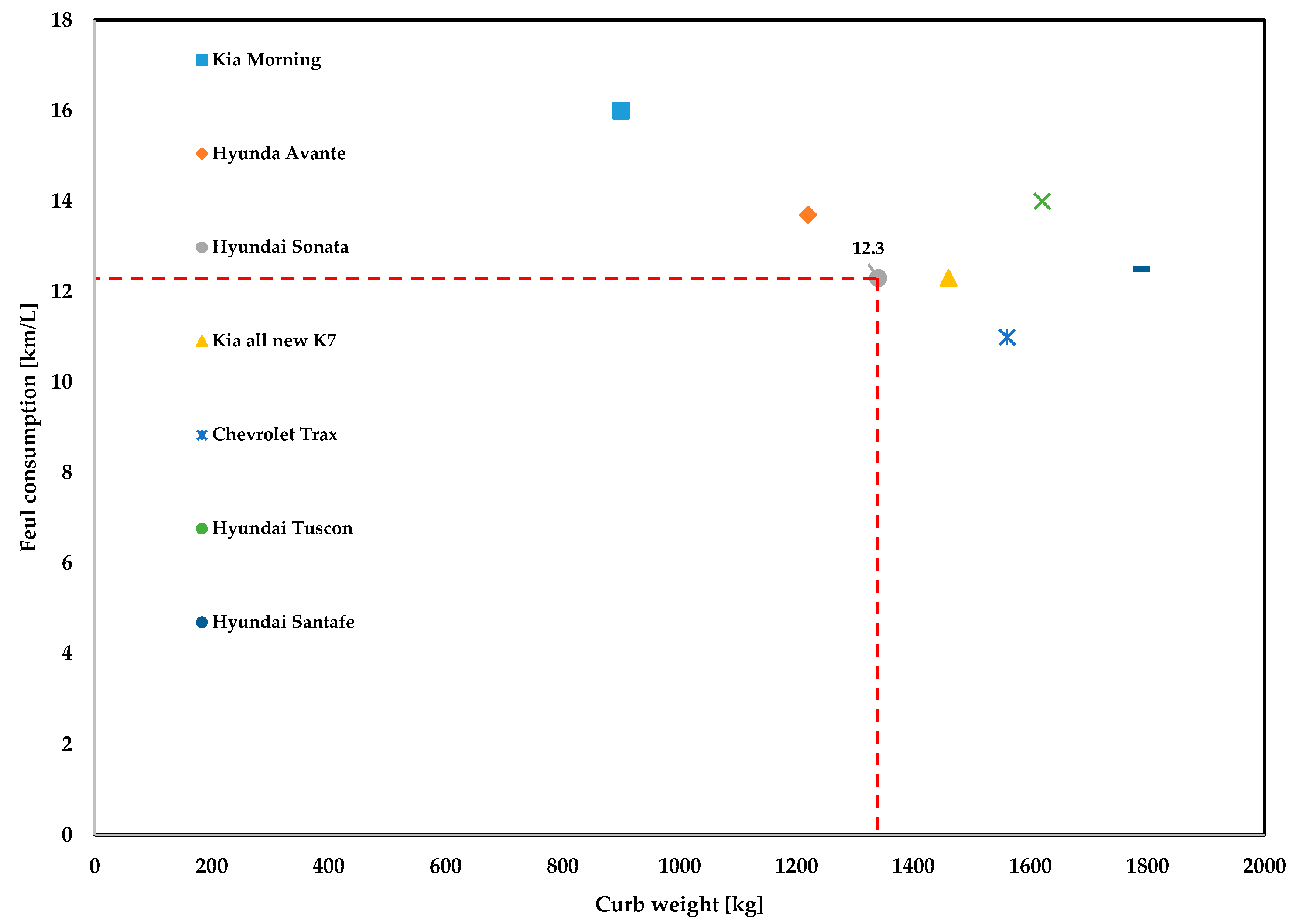

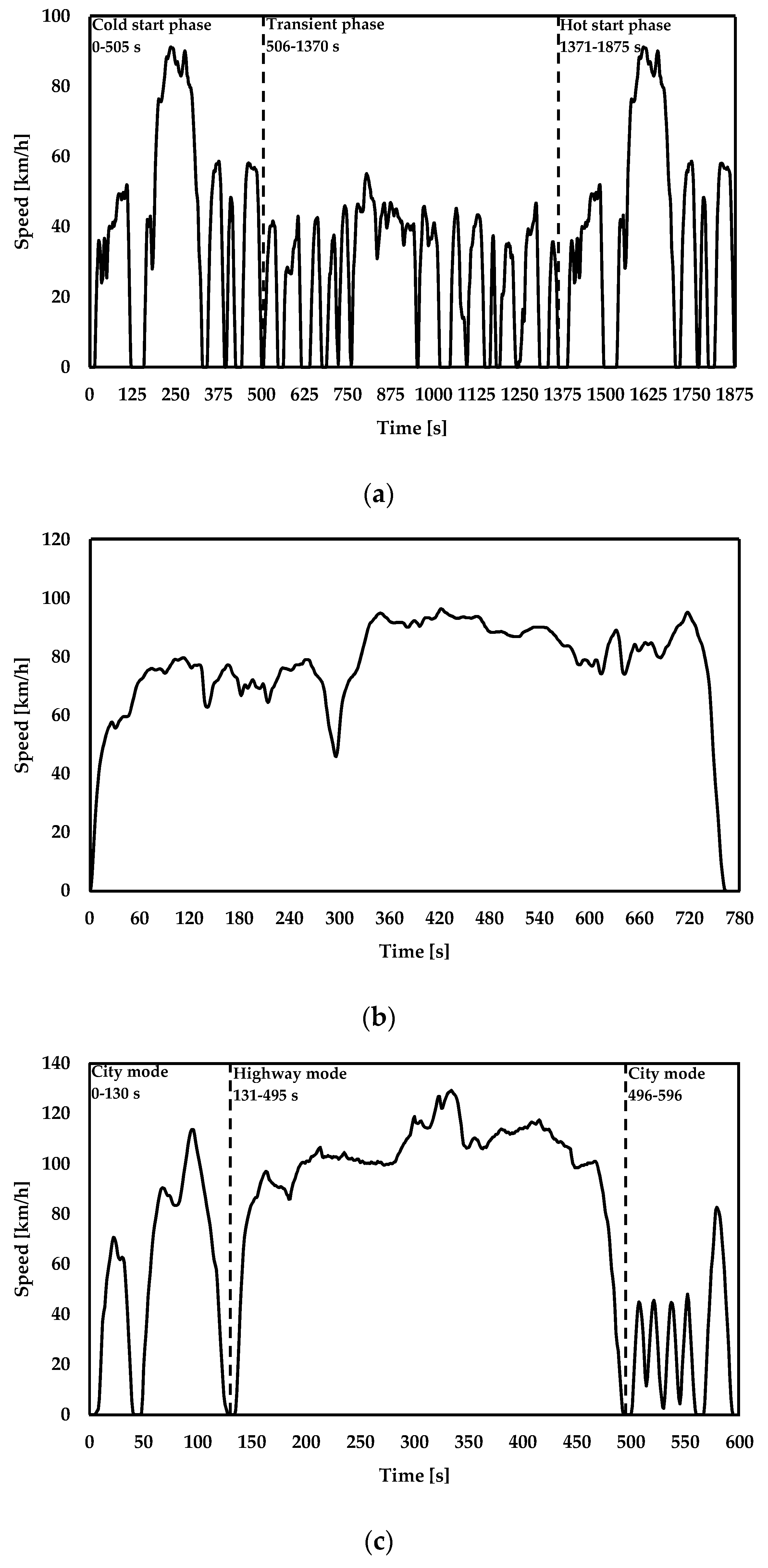
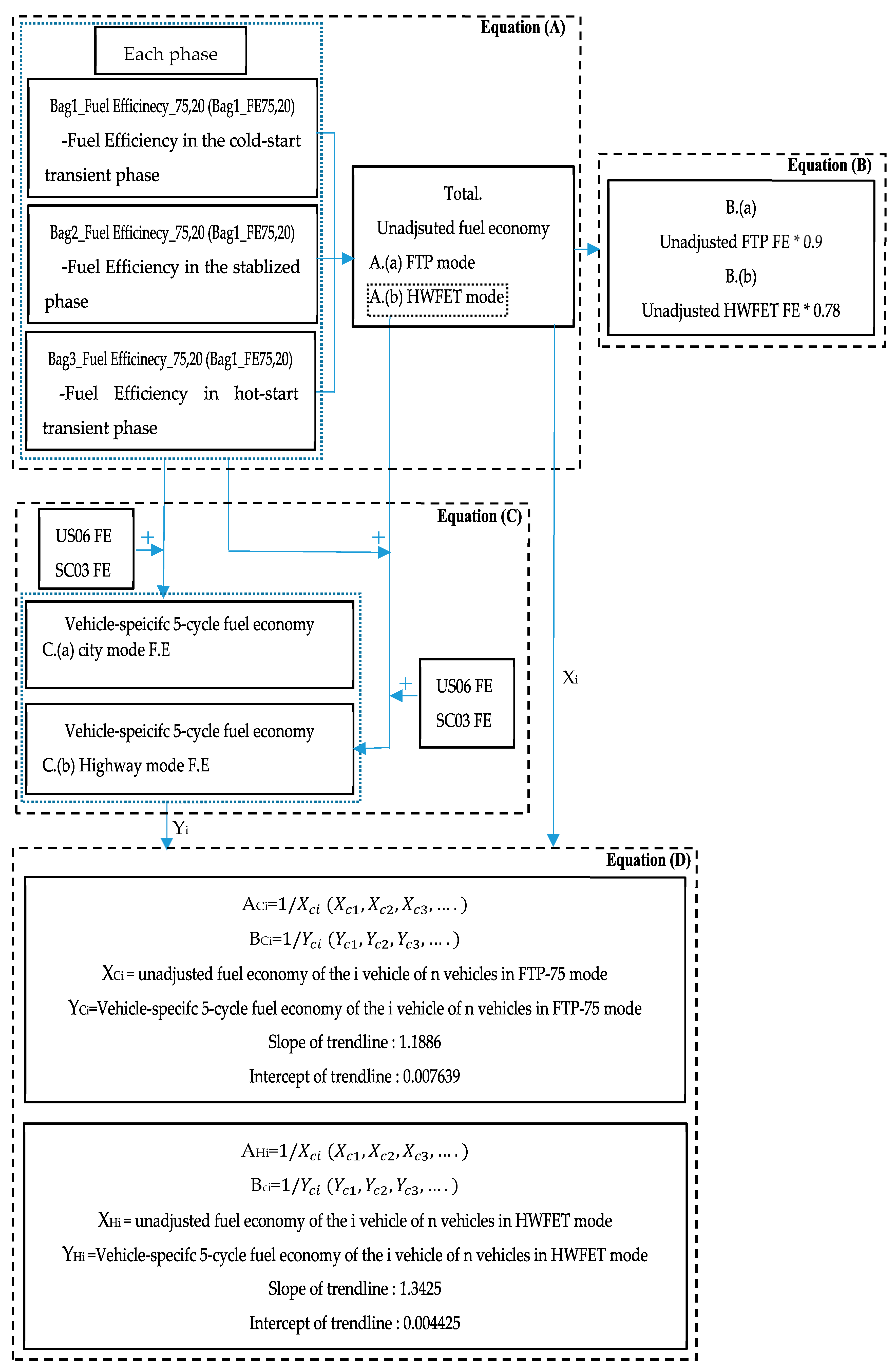
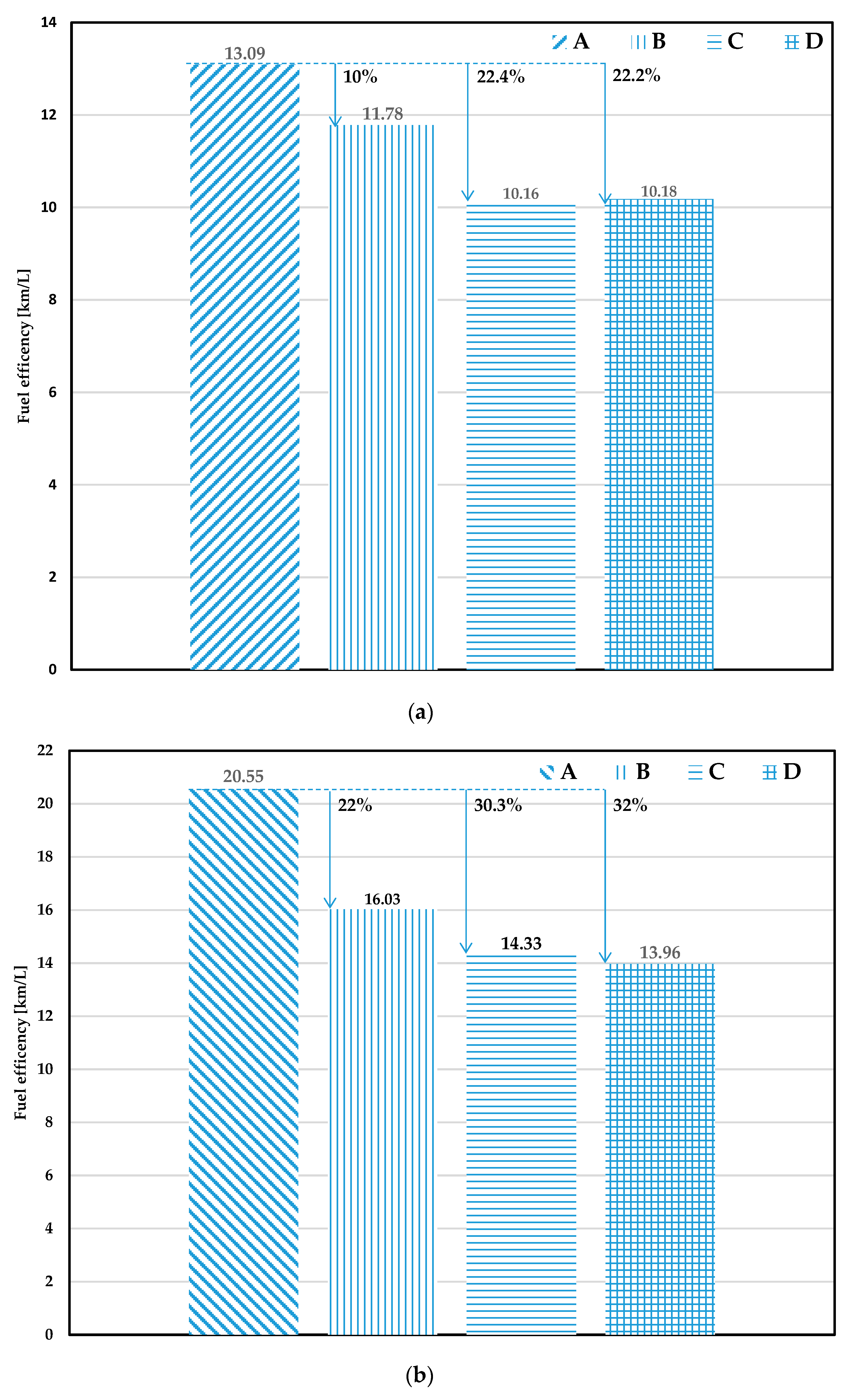
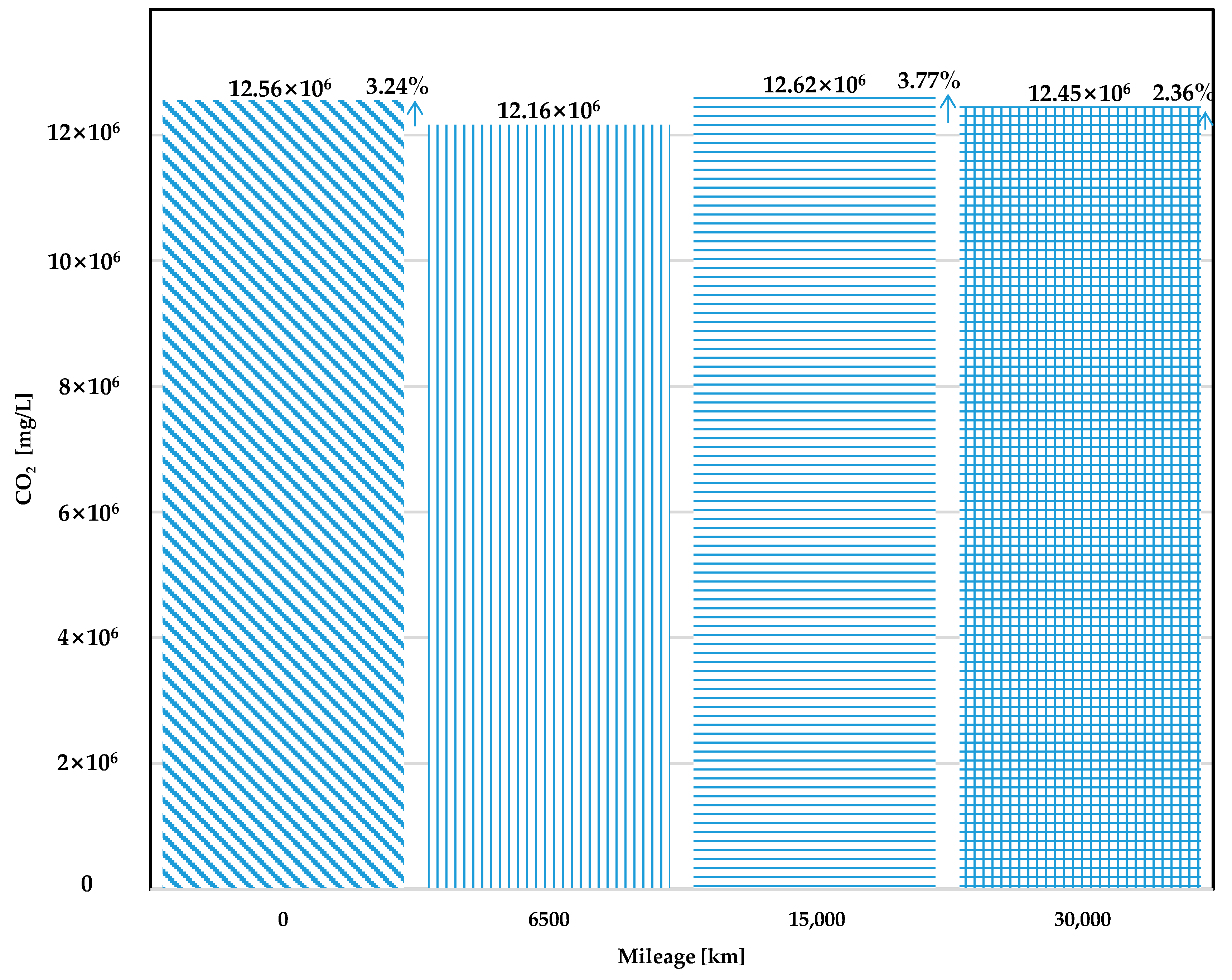
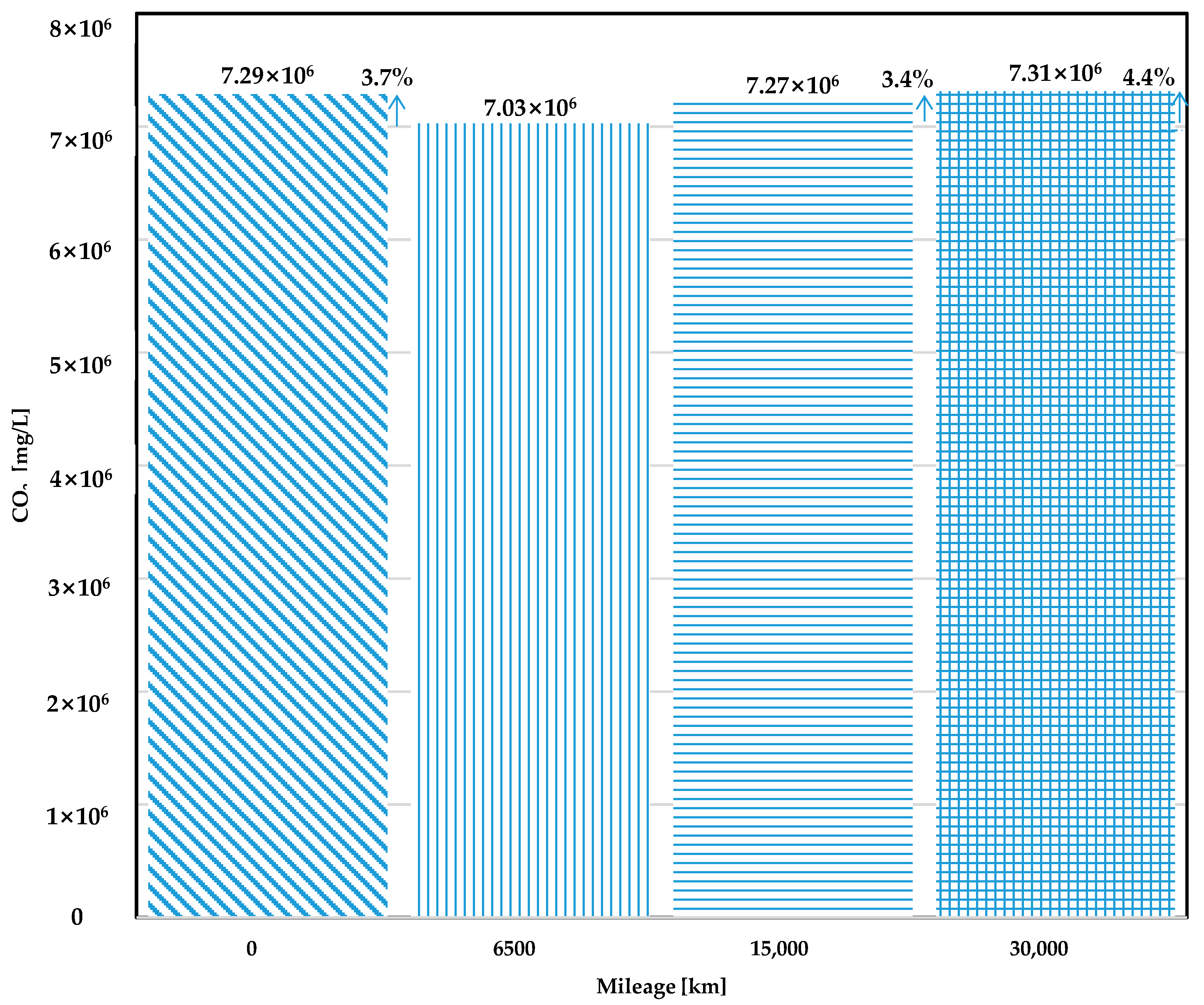

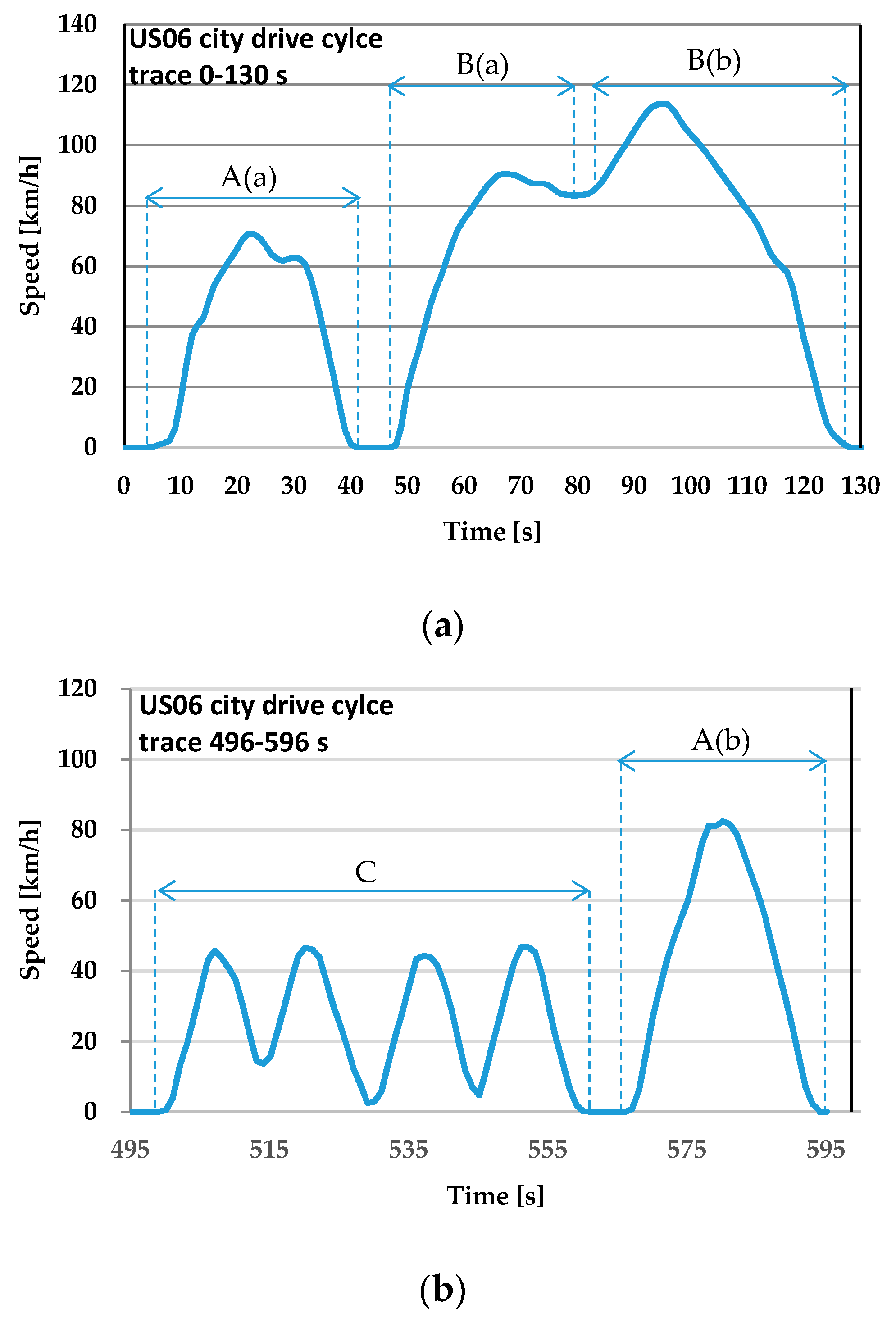


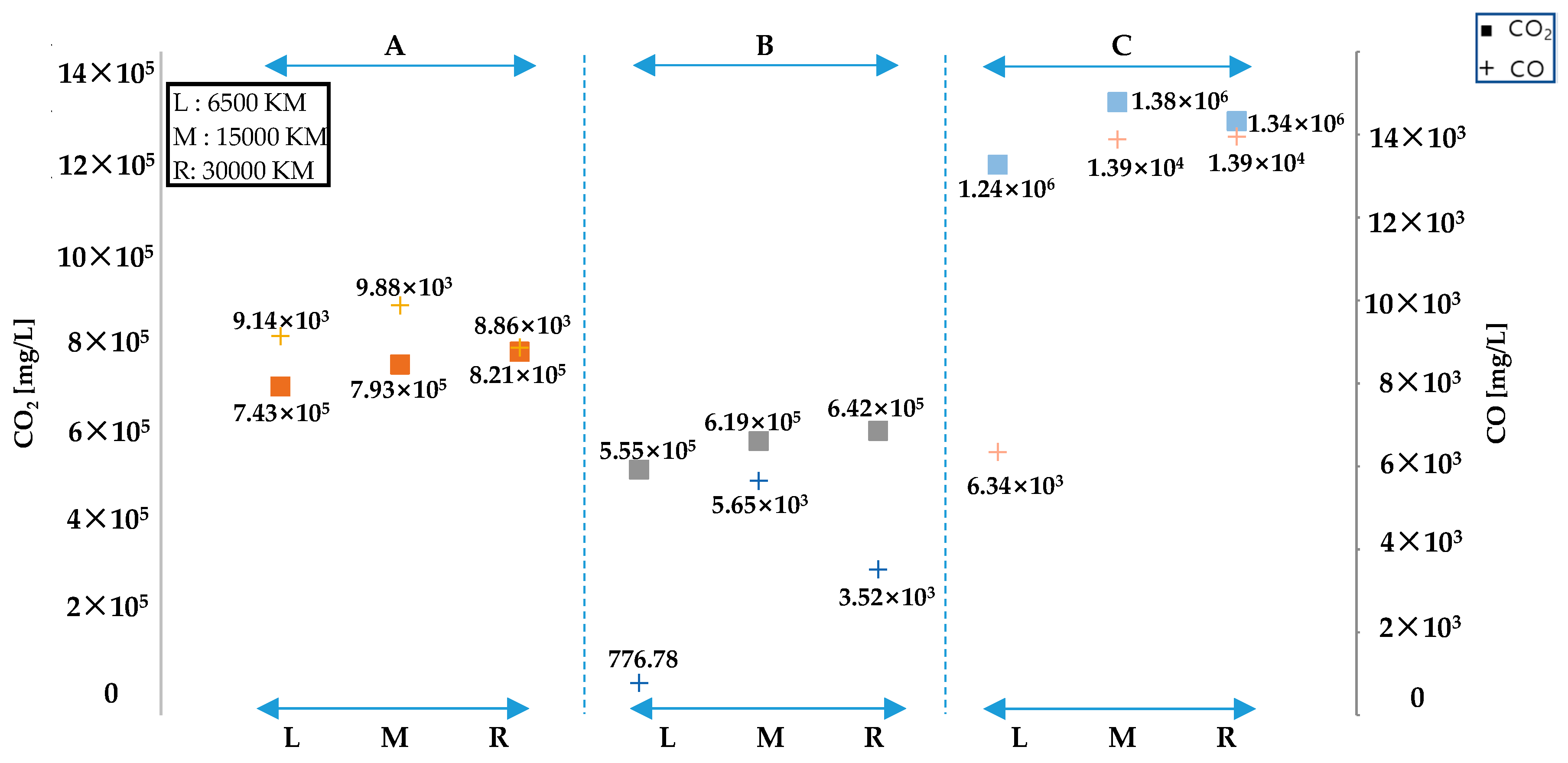

| Item | Unit | Specification | |
|---|---|---|---|
| Engine | Bore × stroke | mm | 88 × 90 |
| Displacement | cc | 1999 | |
| Valves per cylinder | - | 4 (2 intake and 2 exhaust) | |
| Compression ration | - | 16 | |
| Engine type | - | l4 | |
| Vehicle | Overall length | mm | 4855 |
| Overall width | mm | 1865 | |
| Overall height | mm | 1475 | |
| Wheel base | mm | 2805 | |
| Vacant weight | kg | 1460 |
| Item | Specification |
|---|---|
| Roll type & diameter | Roll type & diameter Single Roll (48 inch MIM type) |
| Simulated vehicle weight | 454~5400 kg |
| Electric motor absorber type | AC IGBT |
| Max. speed | 200 km/h |
| Registration of actual speed value | ±0.01% km/h |
| Registration of actual tractive force value | ±0.1% F.S. (5870 N) |
| Measurement of driving distance | Encoder type |
| Max. flow rate of cooling fan | 63,000 CFM |
| Case | Equations for Fuel Consumption | |
| A | (a) Total exhaust gas concentration for HC, CO and CO2 measured during the FTP cycle. (b) Fuel efficiency for the vehicle powered by LPG. | |
| Ywm = (CO, CO2, NOx, HC, CH4, and NMHC) Weighted exhaust gas mass(g/km, g/mile) Yct = mass of emission at the initial stage of cold start test (g/test phase) Yht = mass of exhaust gas (g/test phase) at the initial stage of the hot start test Ys = mass of exhaust gas (g/test phase) at the stabilization stage of cold start test Dct = driving distances (km, mile) at the initial stage of the cold start test. HC, CO, and CO2 (g/km) = the exhaust gas concentration obtained from the above equation. CWF = the ratio of carbon content in the fuel. SG(g/mL) = the fuel density. NHV(J/g) = calorific power. | ||
| B | (a) City mode F.E = FTP_75 F.E × 0.9 | (b) Highway mode F.E = HWFET F.E × 0.75 |
| FTP_75 F.E: the fuel efficieny for FTP-75 cycle HWFET F.E: the fuel efficiency for HWFET cycle | ||
| C | (a) City mode F.E = 0.905 × | |
| Running FC | ||
| StartFuel75 = (3.6/Bag1_FE75) − (3.6/Bag3_FE75) | ||
| StartFuel20 = (3.6/Bag1_FE20) − (3.6/Bag3_FE20) | ||
| (b) Highway mode F.E = 0.905 × () | ||
| D | (a) City mode F.E | (b) Highway mode F.E |
© 2018 by the authors. Licensee MDPI, Basel, Switzerland. This article is an open access article distributed under the terms and conditions of the Creative Commons Attribution (CC BY) license (http://creativecommons.org/licenses/by/4.0/).
Share and Cite
Lim, J.; Lee, Y.; Kim, K.; Lee, J. Experimental Analysis of Calculation of Fuel Consumption Rate by On-Road Mileage in a 2.0 L Gasoline-Fueled Passenger Vehicle. Appl. Sci. 2018, 8, 2390. https://doi.org/10.3390/app8122390
Lim J, Lee Y, Kim K, Lee J. Experimental Analysis of Calculation of Fuel Consumption Rate by On-Road Mileage in a 2.0 L Gasoline-Fueled Passenger Vehicle. Applied Sciences. 2018; 8(12):2390. https://doi.org/10.3390/app8122390
Chicago/Turabian StyleLim, Jaehyuk, Yumin Lee, Kiho Kim, and Jinwook Lee. 2018. "Experimental Analysis of Calculation of Fuel Consumption Rate by On-Road Mileage in a 2.0 L Gasoline-Fueled Passenger Vehicle" Applied Sciences 8, no. 12: 2390. https://doi.org/10.3390/app8122390




